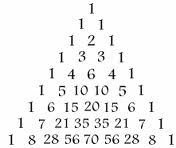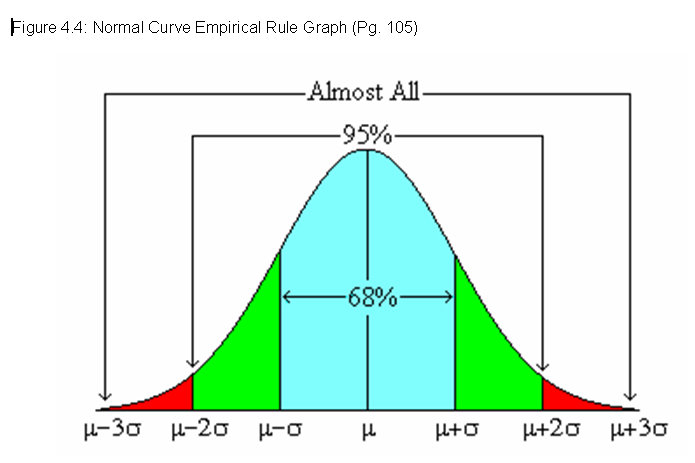- Your quiz is returned (key).
- 16 ways; 4 have exactly three heads; 11 have two or more heads.
- 36 ways to roll. Sums of 9 or more in 10 ways; 7 or 11 in 8 ways.
- Probabilities are numbers between 0 and 1.
- Certain: 1
- Impossible: 0
- 50/50: .5
- 2 to 5: 2/7
- 23 people in a room make it more likely than not that two
will share a birthday.
Probability of 4 different birthdays is
- This Friday you have an exam. It will cover the four topics
- Graphs
- Algebra
- Mobius bands
- Probability
- The "New Normal" refers to the normal (or bell-shaped) curve, and then its "replacement" -- the fat-tailed distributions.
- What is this Normally Distributed Data?
- Statistics are closely related to probability, which is why they're
grouped together in our reading ("Students would be better served by learning
more about probability and statistics", p. 175), and which is why we're studying them right
after studying probability.
Our author says that, while it's true that "you'll find later in life that it's handy to know what a standard deviation is", it is "even handier to know what a distribution is."
So our objective in this unit is to understand three things, actually:
- A distribution
- Measures of central tendancy (mean, median)
- Measures of spread (standard deviation)
- Let's start with heights of NKU students:
- We collect data;
- construct a histogram, or graph of the data, grouping the data into "bins"; then
- attempt to describe the distribution of the data using
statistics. Some of the tools we use are
- A catalog of distributions
- Measures of central tendancy (mean, median)
- Measures of spread (standard deviation)
By "catalog of distributions" I mean some candidates for the model behind the data. We may discover that the data looks symmetric, for example, which would rule out a bunch of types of distributions. If the histogram of the data is bell-shaped, then perhaps it is normally distributed, which is what are author is interested in discussing here.
- Some of my favorite statistics:
- The average American has one testicle and one ovary.
- The average income for a Lakeside School (Seattle, Washington) graduate was $2.5 million. (In 1997)
How can we explain these two statistics? Let's start with that first one. Is it true that the average American has one testicle and one ovary? Think about how the average -- or mean -- is defined.
- The mean is only one measure of "central tendancy", or
measure of the middle of a data set.
Let's try a different measure of "central tendency":
The median American has no testicles and two ovaries.Mean and median try to characterize the "middle" of a distribution. Do you know how they're defined?
Why do these values of mean and median make sense? What is the distribution of testicles and ovaries?
- What is normally distributed data?
- Certainly you've rolled
dice.....
This simulation produces a variety of distributions. What are their properties?
- Normally distributed data is symmetric -- it's as likely to be above the mean as below the mean.
- Hexstat probability demonstrator (the "Galton board") gives normally distributed data.
- Pascal's Triangle and the normal curve

- Certainly you've rolled
dice.....
- A lot of data exhibit the normal curve - but some data don't!
- Replacing a histogram by a smooth curve....
How is our mathematician doing at modeling the data?
What has she missed?
- Replacing a histogram by a smooth curve....
- The Empirical Rule (for normal data)

- The greek letter
represents the "standard deviation", which is the spread of the data. The larger
is, the more spread out the normal curve becomes. It's still bell-shaped -- it's just broader and flatter.
- Percentages in categories, by using
as a measuring stick.
- Practical
Example
We can now answer a few of these questions using the empirical rule.
- The greek letter
- On page 178, we see that people exaggerate their heights -- this shows up as a shift in the mean, in the position of the middle of the data. Interesting use of statistics, isn't that!
- Statistics are closely related to probability, which is why they're
grouped together in our reading ("Students would be better served by learning
more about probability and statistics", p. 175), and which is why we're studying them right
after studying probability.
- Fat tails:
- Examples:
- power law distribution of cities (p. 179)
- wind power production
- Bush's use of the mean versus the median in a fat-tailed distribution (p. 181) could be viewed as casting something (in this case a tax rebate) in the best light. It and the statistic about Lakeside School are in the same class. Do you know why Lakeside School has such a great mean (or did in 1997)?
- Examples: